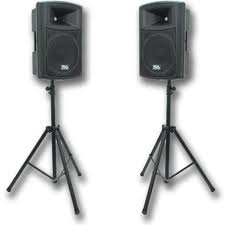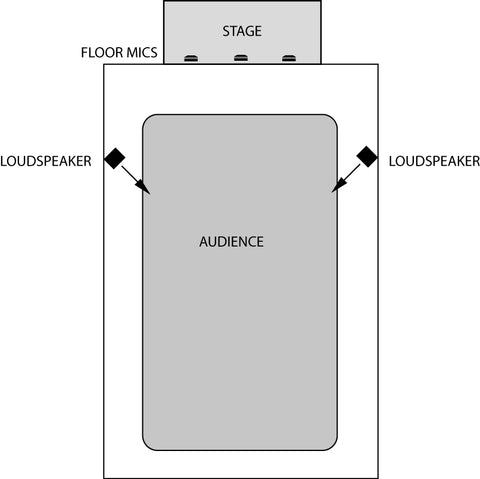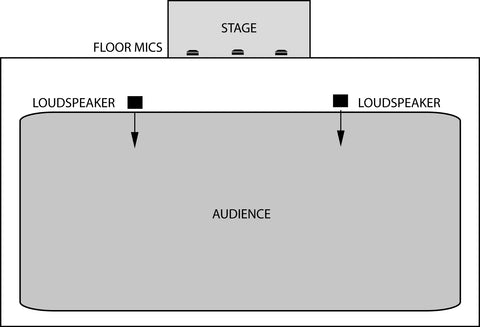Reducing feedback with floor mics
VERY IMPORTANT: Place the loudspeakers close to the audience and far from the microphones. Your existing speaker placement might work fine. But if you have trouble with feedback, I recommend that you buy, borrow or rent two portable PA speakers and speaker stands. You might want to use a separate powered mixer as well.

Start with just two speakers and place them near (or mounted on) the side walls, even with the third row from the front, as shown below top. Raise the stands to their full height. That’s an effective placement for reducing feedback. If the sound is too quiet at the back of the theater, add two more speakers farther back. Loudspeaker placement for a wide theater is shown below bottom.


Loudspeakers near the stage tend to cause feedback. Then why are many auditoriums designed with the loudspeakers installed there? Those sound systems were designed for close-miked performances, in which feedback is not a problem. However, distant miking with floor mics requires a different speaker placement to minimize feedback.
I'd recommend a 2-way loudspeaker that combines a 10” to 15” woofer and a horn tweeter. The tweeter ideally has a coverage angle close to 90 degrees horizontal and 40 degrees vertical, but other angles can work. In a reverberant gymnasium, use column speakers or line array speakers to prevent muddy sound. The Soundtown CARPO-P6LB is an affordable column-speaker pair, and the Soundtown STSD-71B is an affordable pair of speaker stands.
Loudspeaker examples: Electro-Voice ZX1, JBL PRX412M, Carvin PM10, Peavey PVx 12. Speaker stand examples: Pyle Pro PSTND2, On-Stage Stands SS7761B, Ultimate Support TS-80B.
Have a sound person turn the mic faders up or down on the mixer to follow the action on stage. Ideally only one mic is on at a time. The more mics that are turned up, the more feedback.
Place the mics as close to the actors as possible without getting in their way.
Ask the actors to talk loudly toward the audience. Tell them when you can’t hear them. The microphones need something to pick up.
If your mixer allows, switch in a 100 Hz highpass filter (lowcut filter) on each mic channel. Use 200 Hz for children.
Do not use compression. It softens loud sounds, and you might need that extra volume.
Do not put each mic on a foam pad - that does not reduce footstep noise, and it reduces clarity of speech. Rubber-soled shoes or moccasin-type shoes reduce footstep noise.
Optional but very helpful: Use a 1/3-octave graphic equalizer between the mixing console and the power amplifier, or plugged into the mic channel's insert jacks. Turn down frequencies that feed back just to the point where ringing stops.
If the stage is carpeted, put each mic on an 18-inch-square panel of masonite or other hard material, 1/8" thick or less. That prevents muffled sound.
